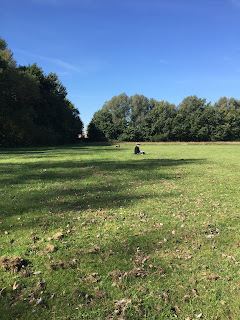At the end of January four women gathered in a room at King's Manor in York. They came from different disciplines and backgrounds, and travelled from across the country, from the Midlands and Cumbria, to meet in this room.
On the table they laid out books, texts, postcards, pamphlets, laptops, badges and biscuits. After pushing random buttons on a coffee machine, and discovering that it made no difference, the coffee came out the same anyway, the Ecocriticism Study Day began.
Each of the women had chosen a 'text' of differing sorts, and the other three were to read them before the day. The aim of the day was an experiment: if we bring together four people from very different disciplines to present and comment on each other's approaches to a subject, will they discover a new and shared methodology?
The subjects in question: woodlands and walking.
The women:
Dr Freya Sierhuis, lecturer in English literature and eco-criticism
Dr Lynda Dunlop, educator in science
Dr Suzi Richer, archaeologist and palynologist
Jo Dacombe, artist and creative walker
The discussion began with Lynda thinking about the pedagogy of philosophy, specifically pedagogy outside of the classroom. What are the different motivations people have for engaging with philosophy? How does the space in which learning is happening change the way people learn? Could philosophy be taught through walking?
Freya introduced notions of Environmentalism, and the idea of "Slow Violence" as described by Rob Nixon. How does critical literature become activism when dealing with subjects such as "environmentalism of the poor"? They also discussed the impact of colonialism, and how to measure impact; how measurements can be presented to back up any argument, depending on where one chooses to place the boundaries of how those measurements are made.
Freya went on to examine further the politics of landscape, vernacular landscape and the notion of
vitalism, as discussed in John Wylie's book 'Landscape'.
Suzi made an excellent presentation on pollen diagrams, how they could be interpreted and some of the problems of presenting the information. She related this to an intriguing book of poems by Richard Skelton and Autumn Richardson, 'Of the Elm Decline', which generated in-depth discussion on the use
of the page in poetry and the visual arrangements of words, poetry referencing science
and the effect of knowing or not knowing the meanings of technical words used
in a poem.
Finally, Jo presented a work by artist John Newling called 'Dear Nature', a work that literally addresses nature through a short letter, but also concerns context, relationships, material, generosity and exchange and other ideas that were unpicked from this work located in a forest in Scotland.
Several themes seemed to reoccur throughout the discussions, enabling the group to identify common concerns. The
naming of things was discussed more than once, and the power in words to change the way we conceptualise the things we name. The effect of a
sense of place was a common theme, and the use of
words and images together to augment meaning.
All four women agreed that the day was useful and, if opportunity arose, a further Study Day could be held.
Following a full day in a room, the group went to
St Nick's nature reserve and walked in the woods there. Plans began taking shape for workshops that they will hold in the woods for students of the University of York in the summer. The Study Day certainly seemed to have tied together some of the common threads between their practices, and it will be exciting to see how this will support the
Imagining Woodlands work with students later in the year.
Thanks to Freya for initiating and organising the Study Day.
Study Day Reading List:
Philosophy: A School of Freedom, (UNESCO: 2007) chapter 4.
Rob
Nixon,
Slow Violence
and the Environmentalism of the Poor,
(Harvard University Press: 2011) Introduction.
John
Wylie,
Landscape (Routledge: 2007)
chapter 6.
Richard Skelton and Autumn Richardson,
Memorious Earth, (Corbel Stone Press: 2015) chapter v.
John
Newling,
‘Dear Nature’




















